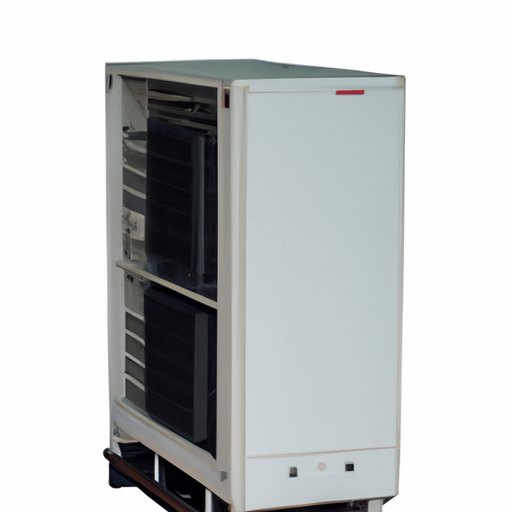Introduction
The process of refrigeration has been around for centuries and is essential to our modern day lives. Refrigeration is a process that removes heat from a material or space in order to cool it down. A refrigerator is a device that uses this process to keep food and other items cold. In this article, we will explore how does a fridge work, looking at the physics, mechanics, and environmental impact of refrigeration.

Explaining the Physics of Refrigeration: How a Fridge Cools Your Food
In order to understand how a refrigerator works, it is important to first understand the basic principles of heat transfer. Heat is transferred from one object to another when there is a difference in temperature between them. This transfer of heat can occur through conduction, convection, or radiation. In a refrigerator, heat is transferred from the inside of the appliance to the outside using these three methods.
The cooling process in a refrigerator occurs when the heat is removed from the inside of the appliance and dissipated into the outside environment. This is done by a compressor that pumps a refrigerant liquid throughout the system. The refrigerant absorbs the heat inside the fridge and then carries it outside where it is released into the atmosphere.
A Step-by-Step Guide to Understanding the Refrigerator Cycle
To better understand how a fridge works, let’s take a look at the thermodynamics of a refrigerator. The cycle begins when the refrigerant enters the compressor as a low-pressure gas. The compressor then increases the pressure of the refrigerant, which raises its temperature. The high-pressure, hot gas then moves to the condenser coils, which are located on the back or side of the refrigerator. The condenser coils release the heat absorbed from the inside of the fridge into the air outside.
Next, the refrigerant travels through an expansion valve, where its pressure is dropped and it becomes a low-pressure, cold liquid. This cold refrigerant then passes through the evaporator coils, which are located inside the fridge. The evaporator coils absorb the heat from the inside of the refrigerator and the cold refrigerant turns back into a gas. The cycle then repeats itself, with the refrigerant returning to the compressor and the process starting again.

The Mechanics Behind Refrigeration: A Look at the Components of a Fridge
Now that we have a basic understanding of the thermodynamics of a refrigerator, let’s take a closer look at the components that make up a fridge. The most important component is the compressor, which is responsible for compressing the refrigerant and increasing its pressure. Other components include the refrigerant, condenser coils, expansion valve, and evaporator coils.
The compressor pumps the refrigerant through the system, increasing its pressure and temperature. The refrigerant then flows through the condenser coils, which release the heat absorbed from the inside of the fridge into the air outside. The refrigerant then passes through the expansion valve, where its pressure is reduced and it turns into a cold liquid. Finally, the cold refrigerant passes through the evaporator coils, which absorb the heat from the inside of the refrigerator and turn the refrigerant back into a gas.
How Refrigerators Use Compressors and Refrigerant To Keep Your Food Cold
In order to understand how a refrigerator works, it is important to understand the relationship between pressure and temperature. As the pressure of the refrigerant increases, so does its temperature. As the pressure drops, the temperature also decreases. This is why the compressor is so important – it is responsible for compressing the refrigerant and increasing its pressure, thus raising its temperature.
When the high-pressure, hot gas passes through the condenser coils, the heat is released into the air outside. This causes the pressure of the refrigerant to drop, and its temperature to decrease. The cold refrigerant then passes through the expansion valve, where its pressure is further reduced and it turns into a low-pressure liquid. The cold liquid then passes through the evaporator coils, absorbing the heat from the inside of the fridge and turning back into a gas.
What Are the Benefits of Having a Refrigerator?
There are many benefits to having a refrigerator, including convenience, energy efficiency, and cost savings. Refrigerators provide a convenient way to store food and other perishables, allowing us to keep them fresh for longer periods of time. Additionally, modern refrigerators are designed to be energy efficient, helping to reduce electricity costs. Finally, refrigerators can save money by reducing food waste, as they help to keep food fresh and edible for longer periods of time.
The Environmental Impact of Refrigerators: How Efficient Is Your Fridge?
While refrigerators have many benefits, they also have an environmental impact. Refrigerants used in refrigerators have been found to have a negative impact on the environment due to their emissions of ozone-depleting gases. Additionally, the energy consumption of refrigerators can have a significant impact on the environment, as they require large amounts of electricity to operate.
Fortunately, many modern refrigerators are designed to be more energy efficient, using less electricity and producing fewer emissions. It is important to research the energy efficiency ratings of refrigerators before purchasing in order to ensure that you are buying an appliance that is good for the environment.
Conclusion
Refrigerators play an important role in our lives, providing us with a convenient way to store and preserve food. By understanding how a fridge works, we can better appreciate the science behind the process of refrigeration. We can also make informed decisions about the appliances we purchase, ensuring that they are energy efficient and have minimal environmental impact.
(Note: Is this article not meeting your expectations? Do you have knowledge or insights to share? Unlock new opportunities and expand your reach by joining our authors team. Click Registration to join us and share your expertise with our readers.)
